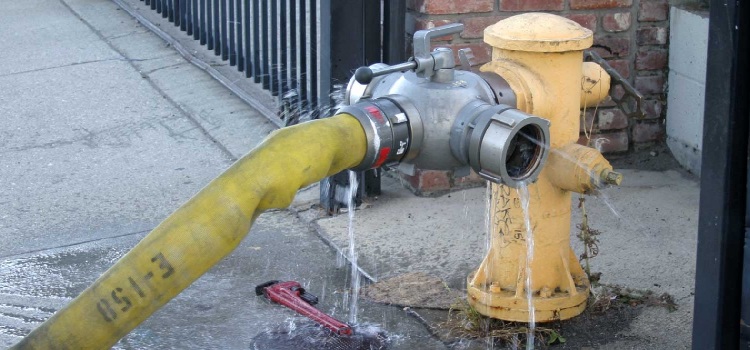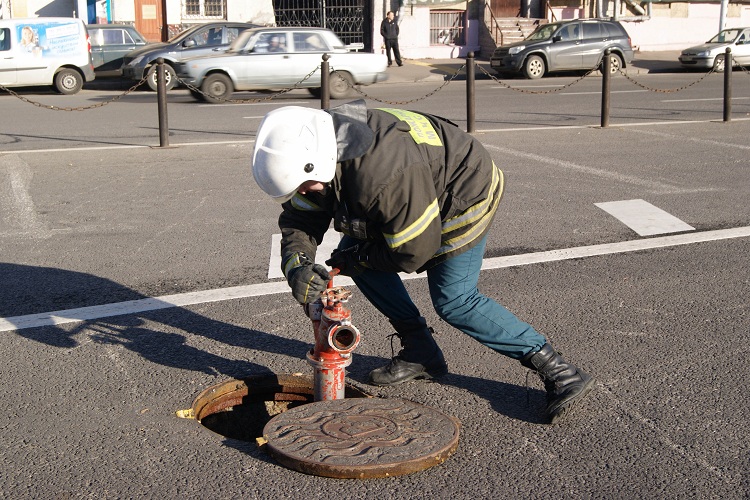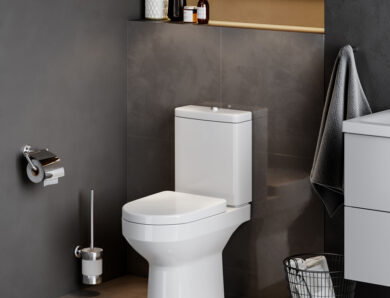
Fire hydrant: requirements for installation and features of operation
A fire hydrant is a device, which is connected to the water supply and provides convenient water intake from it. The main function of such equipment is, that it acts as a point, to which the fire hoses are joined, used to eliminate various sources of ignition. Ancillary function of GHG - reclamation activities.

Installation, maintenance and operation of fire hydrants must be carried out in accordance with established rules
Varieties of fire hydrants
What is a fire hydrant? These devices are indispensable in firefighting. They take water from the water supply, and then pass it to the fire hoses under a certain pressure. The fire hydrant can be cast iron or steel. PG, usually, are used in suburban areas and are classified according to a simplified version of the installation into two main varieties:
- device, which are located in wells. They are also called underground fire hydrants;
- overhead or wellless devices.
What are underground fire hydrants? Underground devices are the most popular and today they are the most commonly used to provide fluid supply for various needs.. Their popularity is due to ??team, that they provide uninterrupted supply of liquid from the water supply.
Consider the basic rules for placing such equipment in wells:
- GHG installation must be performed in accordance with state standards (GUEST);
- it is allowed to install fire hydrants of various shapes and sizes;
- the tap of the device must be placed on the surface;
- the temperature of the working environment in plumbing, to which the fire hydrant in the well is connected, must be above zero. Otherwise, its operation is impossible;
- the temperature of the working environment in communication, transports cold water, should be at least +5 ° C. The maximum temperature in this case should not exceed 50 ° C;
- pressure indicators, which can withstand this device, should not be higher 10 MPa;
- installation of GHG in the well is performed only in the vertical plane and nothing else;
- special stands are used for reliable fastening of the device;
- before installing the GHG, it is recommended to rinse it with water from a well;
- the design of the device must take into account taps, to which it will be possible to connect a fire hose without hindrance.
Hydrants are above ground and underground, the first are located on the ground and do not require a well device
pay attention! If such a device is used very often, then it needs to organize a fire line. This line is installed around the perimeter of the well. The fire line consists of pipelines and hoses, which are located on the perimeter of the required strategic objects.
To simplify GHG installation, usually, the corresponding instruction is attached to it. This technical document includes three main provisions:
- Description of installation.
- Wiring diagram (fire hydrant schemes may be different, depending on the design features of the equipment).
- The sequence of actions during installation.
To study the structure of GHG, you can see the designation of the fire hydrant in the drawing. In the drawings, usually, all structural elements of this device are marked.
What are overhead fire hydrants? Fireless fire hydrant is used much less often and is more complex (from a constructive point of view) device. Usually, such GHGs are mounted on manholes, but, there are devices, installed on the soil surface. A water source is required to organize such water intake equipment, which location should be nearby.
In winter, the above-ground fire hydrant must be drained, otherwise the frozen water inside it will render the device unusable. Many overhead models have an automatic drain function, which is very convenient.
The underground hydrant is not so convenient in work, as overhead, but it does not require draining the water in winter
Requirements for the well
Experts recommend turning to professionals for this, to calculate the required parameters of the well, in which the water intake device will be located. However, if desired, you can make all the calculations yourself. But such work is difficult and quite responsible. There are several basic requirements for such wells, which are worth paying attention to:
- it is not recommended to organize a very deep well. Fluid must be supplied from the well;
- no need for water purification, coming from the well. The main requirement in this case is, so that there are no large alien elements in the water (stones and other debris);
- the width of the well must be at least 80 cm. This is necessary for the normal operation of the equipment;
- the main material for the construction of such a well are polymer pipes with high cross-sectional dimensions, as well as reinforced concrete rings, which are necessary for the organization of the "skeleton" of the structure;
- it is strictly forbidden to lower the fire hydrant underground into the unfinished well, as any landslide can lead to this, that the water intake device will fill up with the earth.
Guided by the above requirements and performing the necessary calculations, you can install the well yourself.
Requirements for fire hydrants
Installation of GHGs must be carried out in accordance with certain rules and regulations, which are specified in the relevant technical documentation.
Type and number of hydrants, installed on an object, regulated by the rules of SNiP
Consider some factors, which must be taken into account before installing a water intake device:
- the height of the building and the total number of floors in it;
- fluid consumption, which is required to extinguish a specific structure in case of fire;
- fire hydrant capacity.
Consider the basic requirements, which are put forward by aboveground GHG:
- the distance from the water intake equipment to the walls of the buildings must be at least 50 m and do not exceed a distance of 100 m;
- the location of the fire hydrant should be as follows, so that the distance from the edge of the road to the device is equal 2,5 m;
Importantly! The organization of a fire hydrant on the roadway is strictly prohibited.
- the distance to the nearest building must be at least 5 m;
- in the case of an auxiliary water supply line, GHG installation is prohibited;
- indicator of cross section of water pipes, from which water will be taken, must be at least 100 mm for urban communication, and for rural - no less 75 mm;
- the consumption of working fluid by one water intake device should not be lower, than 15 l / With;
- the length of the fire hose must be 200 m.
In turn, underground hydrants must be installed, focusing on such requirements:
- the distance from the axis of the water intake device to the wall of the manhole must be at least 17,5 cm;
- the distance from the end of the riser to the hatch cover may vary from 15 to 40 cm;
- if there is a possibility of flooding the well, then the water intake device must be equipped with a special check valve;
- it is necessary to use stands during GHG installation. Such stands prevent water leaks from the water intake device.

The hydrant must be in place, where firefighters are provided with free access at any time
GHG operation rules
Basic rules, which must be observed for the normal operation of the GHG, sound like this:
- water supply must provide the necessary amount of water to extinguish the fire;
- in the winter period of the year it is necessary to take measures to clean GHG from ice;
- designation of the fire hydrant. A sign must be installed next to the equipment, which is necessary for rapid detection;
- GHGs should be freely available. The organization of any obstacles on the way to the hydrant is prohibited;
- the device must be equipped with fire hoses and barrels.
The principle of operation of the fire hydrant is quite simple. To use it, follow these steps:
- Discard the cover of the device and screw the fire column to the nipple. It is very important to ensure the necessary tightness, which is required for good water pressure.
- Further, the handle of the fire column rotates counterclockwise and as a result the valve opens, after which the water first enters the GHG, and only then fills the fire hose.
After operation of the device all above-stated actions are made in opposite sequence. Liquid residues must be drained from the GHG.
To events, which are included in the maintenance of such equipment, include:
- keeping an audit journal;
- monitoring changes in fire communication and their recording;
- preventive inspection, repair and replacement of equipment if necessary.
Testing of fire hydrants
Testing of fire-fighting equipment is a necessary measure, which determine the professional suitability of a device. Such inspections are aimed at detecting problems or failure of fire equipment. During the test, the rapid start-up of water and, in accordance, the pressure in the water intake device is pumped.
Testing of fire hydrants, according to the rules, are held every six months
Trial, aimed at checking the pressure, are performed in the case, if there is a special stand, and the device measures the pressure (pressure gauge). The accuracy class of the measuring instrument must be equal to 1,5. Tests of fire hydrants are made taking into account all necessary regulatory documentation (GUEST 15150).
Importantly! Tests of fire hydrants should be carried out at least 1 times in 6 months.
The following structural elements of fire-fighting equipment must be inspected during the GHG strength test:
- PG case;
- angry channel;
- nipple carving;
- equipping GHG sign.
Fire hydrant drainage and range are calculated during maximum water consumption. After conducting all relevant inspections and inspections of fire equipment, an act of testing of above-ground or underground fire hydrants is drawn up. This act is passed to the owner of the product, to which the GHG belongs and remains with him until the next tests.

